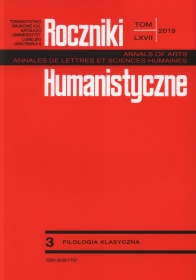The Matter of Semen and the Inheritance of Individual Traits in Aristotle’s De generatione animalium
Abstract
Although, according to Aristotle’s theory of reproduction, in the process of generation a male always transmits form and a female provides matter, in the blooded animals males perform their function with the use of a material tool known as semen or a seminal fluid. Aristotle describes it as a kind of foam consisting of water, earth and pneuma; the last one, being a vehicle of vital heat, causes semen to be fertile. As a seminal fluid is produced from blood – the final stage of useful nourishment, intended to turn into each of body parts of the particular animal whose heart produces it – it is endowed with the same movement or, rather, the same set of movements as that in virtue of which the animal’s body grows. In the process of reproduction these movements not only transmit to the offspring the principle of movement and specific form, but they also attempt to recreate in the offspring’s body individual features of the particular father. For this reason, males which do not emit semen fail to generate offspring that look like themselves.
In this paper I also try to demonstrate that the transmission of individual hereditary characteristics depends not only on pneuma enclosed in the semen, but also on „an earthy element” which forms the envelope, because by preserving and increasing the vital heat it improves the efficiency of the movements.
References
Aristotelis Opera ex recognitione Immanuelis Bekkeri, editio altera quam curavit O. Gigon, Berolini 1960.
Aristotle, Generation of Animals with an English translation by A.L. Peck, The Loeb Classical Library 1953.
Arystoteles, Dzieła wszystkie, t. I-VI, Warszawa PWN 1990-2001.
Balme D.M.: Aristotle’s biology was not essentialist, w: Philosophical Issues in Aristotle’s Biology, red. A. Gotthelf, J.G. Lennox, Cambridge: Cambridge University Press 1987, s. 291-312.
Bos A.P., Aristotle on God’s Life-Generating Power and on Pneuma as Its Vehicle, Albany: SUNY Press 2018.
Connell S.M.: Aristotle on Female Animals. A study of the “Generation of Animals”, Cambridge: Cambridge University Press 2016.
Cook K.C., Sexual Inequality in Aristotle’s Theories of Reproduction and Inheritance, w: Feminism and Ancient Philosophy, red. J.K. Ward, New York–London 1996, s. 51-67.
Cooper J.M., Metaphysics in Aristotle’s Embryology, „Proceedings of the Cambridge Philological Society” 34(1988), s. 14-41.
De Ribera-Martin I., Seed (Sperma) and Kuêma in Aristotle’s Generation of Animals, „Journal of the History of Biology” 2018, s. 1-38.
Eichman P., Sex, Blood and Soul: The Transmission of Form in Aristotle’s Biology, https://echodin.net/papers/phil515/aristotle.pdf, 2007.
Freudenthal G., Aristotle’s Theory of Material Substance: Heat and Pneuma, Form and Soul, Oxford: Clarendon Press 1995.
Gelber J., Form and Inheritance in Aristotle’s Embryology, „Oxford Studies in Ancient Philosophy” 39(2010), s. 183-212.
Gelber J., Causes and Kinds in Aristotle’s Embryology. A dissertation for the DPh degree, Berkeley: University of California 2010.
Gelber J., Females in Aristotle’s Embryology, w: Aristotle’s Generation of Animals. A Critical Guide, red. A. Falcon, D. Lefebvre, Cambridge: Cambridge University Press 2018, s. 171-187.
Henry D., Aristotle on the Mechanism of Inheritance, „Journal of the History of Biology” 39(2006), nr 3, s. 425-455.
Henry D., Embryological Models in Ancient Philosophy, „Phronesis” 50(2005), nr 1, s. 27-40.
Henry D., How Sexist is Aristotle’s Developmental Biology?, „Phronesis” 52(2007), nr 3, s. 251-269.
Henry D., Understanding Aristotle’s Reproductive Hylomorphism, „Apeiron” 39(2006), nr 3, s. 257-288.
Littlehailes L., Vital Heat, Conception and Development in Aristotle. Thesis submitted for the degree of D.Phil, Oxford: Jesus College 1990.
Lones T.E., Aristotle’s Researches in Natural Science, London 1912.
Sowa J., Czy kobieta jest potworem? Płeć żeńska w „De generatione animalium” Arystotelesa, „Roczniki Humanistyczne” 62(2014), z. 3, s. 27-48.
Sowa J., Dlaczego potrzebne, skoro niepotrzebne? O materialnym kształcie przyczyny sprawczej w „De generatione animalium Arystotelesa, „Archiwum Historii Filozofii i Myśli Społecznej” 63(2018), s. 283-298.
Sowa J., O tajemniczych „ruchach” w „De generatione animalium” IV, 3. Płeć żeńska w Arystotelesowskiej teorii dziedziczenia, „Roczniki Humanistyczne” 64(2016), z. 3, s. 31-52.
Sowa J., When does a man beget a monster, „Collectanea Philologica” 19(2016), s. 5-13.
Trompoukis C., Kalaitzis C., Giannakopoulos S., Sofikitis N., Touloupidis S., Semen and the diagnosis of infertility in Aristotle, „Andrologia” 39(2007), nr 1, s. 33-37.
Upton T.V.: Aristotle on Monsters and Generation of Kinds, „American Catholic Philosophical Quarterly” 77(2003), nr 1, s. 21-36.
Witt Ch.: Form, Reproduction, and Inherited Characteristics in Aristotle’s „Generation of Animals”, „Phronesis” 30(1985), nr 1, s. 46-57.
Zwier K.R.: Metodology in Aristotle’s Theory of Spontaneous Generation, „Journal of the History of Biology” 51(2018), issue 2, s. 361-367.
Copyright (c) 2019 Roczniki Humanistyczne

This work is licensed under a Creative Commons Attribution-NonCommercial-NoDerivatives 4.0 International License.





